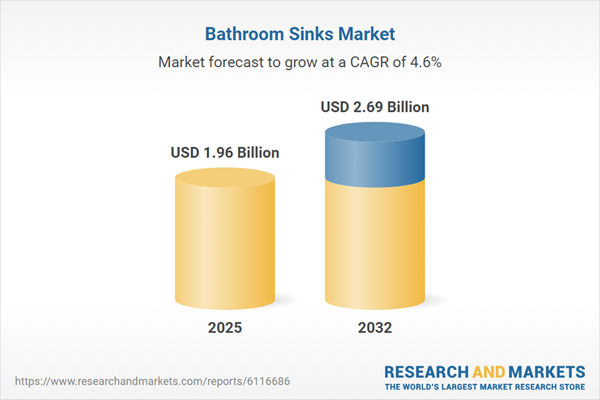Speak directly to the analyst to clarify any post sales queries you may have.
The bathroom sinks market is evolving rapidly as stakeholders seek solutions that balance design innovation with increasing demands for sustainability, hygiene, and technology integration. With material advancements, regulatory changes, and shifting consumer expectations, senior decision-makers in the sector face a dynamic environment that requires strategic insight and agility.
Market Snapshot: Bathroom Sinks Market Growth Trajectory
The bathroom sinks market grew from USD 1.88 billion in 2024 to USD 1.96 billion in 2025 and is projected to expand at a CAGR of 4.56%, reaching USD 2.69 billion by 2032. This robust growth is shaped by increasing demand for style-forward, durable, and hygienic solutions across both commercial and residential applications. Evolving consumer preferences, regulatory shifts, and the incorporation of advanced features are redefining product lifecycles and strategic priorities across all regions. Market participants must navigate this changing environment with a keen focus on differentiation and operational resilience.
Scope & Segmentation of the Bathroom Sinks Market
Comprehensive analysis covers granular sub-segments critical to industry stakeholders across the value chain, including:
- Material Types: Ceramic, composite, glass, stainless steel, and stone options such as granite, marble, and quartz.
- Installation Methods: New construction and replacement projects targeting both broad design plans and compatibility needs.
- Type Categories: Drop-in, pedestal, undermount, vessel, and wall-mounted models spanning mainstream and bespoke applications.
- Shape Options: Oval, rectangular, round, and square configurations addressing diverse stylistic and spatial requirements.
- End User Profiles: Commercial, residential, healthcare, hospitality, and institutional users with unique performance benchmarks.
- Distribution Channels: Offline and online platforms serving trade professionals, DIY consumers, and design specialists.
- Geographic Regions: Americas, Europe, Middle East and Africa, and Asia-Pacific—including major national markets.
- Corporate Landscape: Industry leaders and innovators driving product, technology, and supply chain advancements.
Key Takeaways for Senior Decision-Makers
- Growing prominence of sustainable and antimicrobial materials is shaping product development, as demand for responsible and hygienic solutions intensifies across end-user segments.
- Smart home integration—such as touchless operation and water usage monitoring—coupled with expanding e-commerce channels, is influencing both product design and market reach strategies.
- Commercial establishments, particularly in healthcare and hospitality, prioritize sanitary finishes and regulatory compliance, while multifamily and single-family projects diverge in aesthetics and cost efficiency focus.
- Distribution strategies are adapting to cater to both digitally oriented consumers and professionals seeking convenience, with online platforms extending market access and specialty showrooms curating luxury options.
- Leading manufacturers are investing in proprietary composite blends, advanced finishes, and digital customization techniques to address evolving market expectations and to expand differentiated product portfolios.
- Strategic partnerships, mergers, and supply chain adaptation activities are accelerating vertical integration, reinforcing agility in sourcing, inventory management, and fulfillment.
Tariff Impact on Imports, Supply Chains, and Pricing Strategies
Recent tariff measures in the United States have impacted import costs for certain bathroom sink materials. In response, manufacturers are diversifying sourcing to include domestic and near-shore suppliers, refining logistics to manage lead times and expenses, and seeking long-term agreements with raw material vendors. Retailers are also adapting by introducing value-engineered products and emphasizing locally-produced options. These adjustments have enhanced supply chain resilience and increased the agility of market participants amid ongoing regulatory changes.
Methodology & Data Sources
This report compiles insights from primary interviews with key market participants—including manufacturers, distributors, and trade association representatives—and corroborates findings through an extensive review of industry publications, regulatory filings, and company reports. Rigorous data triangulation and expert validation sessions were conducted to ensure accuracy and relevance of the research outcomes.
Why This Report Matters: Strategic Value for B2B Decision-Makers
- Equips business leaders with actionable insights on material trends, regulatory impacts, and technological advancements to guide investment and innovation.
- Delivers nuanced segmentation analysis, enabling tailored market entry, diversification, and go-to-market strategies that match evolving consumer expectations.
- Provides a holistic understanding of supply chain dynamics and competitive positioning to support resilience amidst geopolitical and economic uncertainty.
Conclusion
As the bathroom sinks market continues to transform, staying ahead requires informed, agile strategies that integrate design, technology, and operational excellence. This report empowers decision-makers with objective intelligence to navigate changing demands and drive sustainable growth.
Table of Contents
3. Executive Summary
4. Market Overview
7. Cumulative Impact of Artificial Intelligence 2025
Companies Mentioned
The companies profiled in this Bathroom Sinks market report include:- CERA Sanitaryware Ltd.
- Franke Holding AG
- Deca
- Delta Faucet Company
- Duravit AG
- Elkay Manufacturing Company
- Gerber Plumbing Fixtures LLC
- Grohe AG
- Hansgrohe SE
- Jaquar & Company Private Limited
- Kaldewei GmbH & Co. KG
- Kohler Co.
- Kraus USA
- Cotto
- LACAVA, L.L.C.
- Laufen Bathrooms AG
- Moen Incorporated
- MTI Baths Inc.
- Neptune Ltd
- Rainbow Ceramic
- RAK Ceramics
- Roca Sanitario, S.A.
- TOTO Ltd.
- Villeroy & Boch AG
- Wetstyle
Table Information
| Report Attribute | Details |
|---|---|
| No. of Pages | 185 |
| Published | November 2025 |
| Forecast Period | 2025 - 2032 |
| Estimated Market Value ( USD | $ 1.96 Billion |
| Forecasted Market Value ( USD | $ 2.69 Billion |
| Compound Annual Growth Rate | 4.5% |
| Regions Covered | Global |
| No. of Companies Mentioned | 26 |









